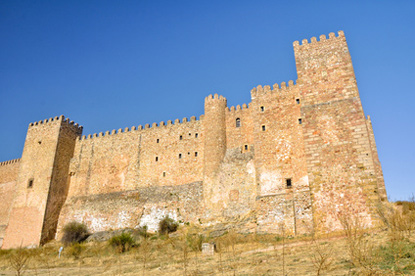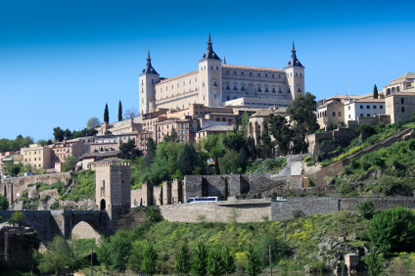Introduction

Formerly known as New Castile, Castile-La Mancha is the third largest, but the most sparsely populated of the 17 Spanish autonomous communities. Expanding on 79,463 km² (30,681 sq mi), it is a bit larger than the Benelux, but is 14 times less populous, with merely 2 million inhabitants.
Most of Castile-La Mancha is made of elevated plains and mountains. It has a dry continental climate, with scorching hot summers and cold winters. The low population density allows for extensive agriculture (wheat, grapes and olives) and animal husbandry (sheep, goats, pigs, cattle). Castile–La Mancha has some of the most extensive vineyards in Europe, nearly 700,000 hectares (1,700 sq mi), producing over half of all Spanish grapes.
The region's most famous sight are the white windmills in Consuegra, that Don Quixote de La Mancha believed to be ferocious giants in Miguel de Cervantes's 17th-century epic novel.
Toledo, the regional capital, was the capital of Castile, then of unified Spain and of the Spanish Empire in the 15th and 16th centuries, until Philip II moved the capital to Madrid in 1561. Madrid was itself a province of the New Castile until 1983, when it became an autonomous community of its own.
Famous people from the Castile-La Mancha include (chronologically): the dramatist Fernando de Rojas, the dramatist Antonio Buero Vallejo, and the film director Pedro Almodovar.
Cuisine
Castilian-Manchego cuisine is sober, filling, and somewhat rustic, reflecting the rural character of the region. Rich, heavy stews are very common during the cold winter months. The most representative dishes of the region include asadillo de la Mancha (skinned, seeded, and chopped red peppers roasted and dressed with garlic, tomato and oil), cocido madrileño (chickpea-based stew with vegetables, potatoes, and various meats), gazpacho manchego (stew of quail, rabbit or other game eaten with pieces of flat, unleavened bread), migas de pastor (leftover bread sautéed in olive oil with garlic and bacon), pisto manchego (vegetable stew with tomato sauce), and salpicón (diced veal with onions, tomatoes, peppers, parsley and garlic).
The characteristic Manchego cheese, a firm, compact and creamy sheep's milk cheese, has a history going back to Roman times. Its colour ranges from ivory when it is young (fresco, aged only two weeks) to brownish-beige for the viejo (aged for one year). It is the best known of Spanish cheeses abroad.
The greatest part of the huge wine production of Castile-La Mancha is cheap table wine. There are however a few high-quality vineyards that earned a Denominación de Origen (D.O.). These are: Almansa, La Mancha (the largest Spanish D.O. region), Manchuela, Méntrida, Mondejar, Ribera del Júcar, Uclés, and Valdepeñas.
Attractions
North
| Sigüenza |
|---|

 Sigüenza |
| Guadalajara |
|---|

 Guadalajara |
Other attractions

Torija Castle
Centre & South
| Toledo ※ |
|---|

 Toledo |
| Windmills of Consuegra |
|---|

 Windmills of Consuegra |
Other attractions

Almansa

Ciudad Real
| Cuenca ※ |
|---|

 Cuenca |
| Alcalá del Júcar |
|---|

 Alcalá del Júcar |
Travel Community
Ask your travel questions on the Spain Travel Forum
| Eupedia's Rating System |
|---|
Cities, towns, villages & historic buildings
- : Local interest
- : Moderately interesting
- : Outstanding place
- : Best of the country - shouldn't be missed
- : Best of Europe
Natural attractions
- : Local interest
- : Moderately interesting
- : Highly recommended
- : World-class natural attraction
- ※ : UNESCO World Heritage site
|